Fellas
One potentially stupid query. I have for this amp's PSU one Amplimo 650VA trafo with 2 18V secondaries and 2 of the black BrianGT CCRC PSU boards, each stuffed with 6 33000uF caps.
Do I use 4 bridges so that I have 2 per board and 2 per secondary, or do I use 2 bridges giving 1 bridge per secondary and then split from there to the 2 PSU boards?
One potentially stupid query. I have for this amp's PSU one Amplimo 650VA trafo with 2 18V secondaries and 2 of the black BrianGT CCRC PSU boards, each stuffed with 6 33000uF caps.
Do I use 4 bridges so that I have 2 per board and 2 per secondary, or do I use 2 bridges giving 1 bridge per secondary and then split from there to the 2 PSU boards?
Follow-through and follow-up
As I mentioned before my available time to work on audio projects is very limited, which sometimes causes delays in completing a build. Here are the final steps I took to resolve the remaining issues with the DIY Aleph J clone using the boards designed by Didiet.
After I determined that both the Ultrafast Recovery and Soft Recovery diodes caused mechanical hum in the transformers, I removed them from the boards and attached Fairchild bridges to the chassis perforated insert.
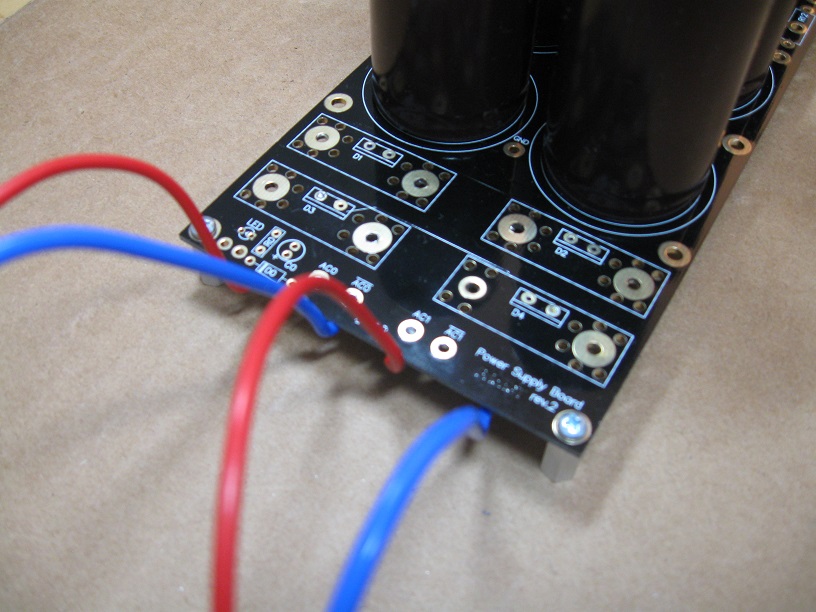
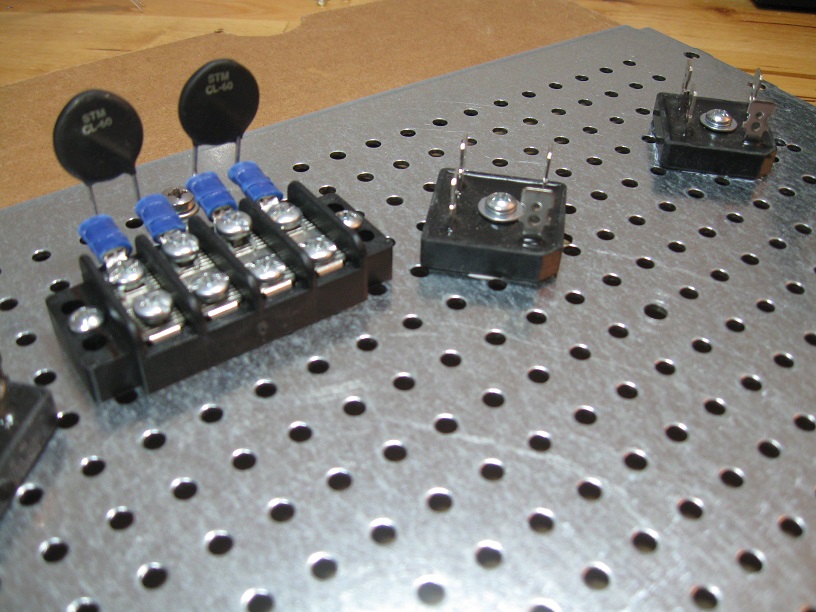
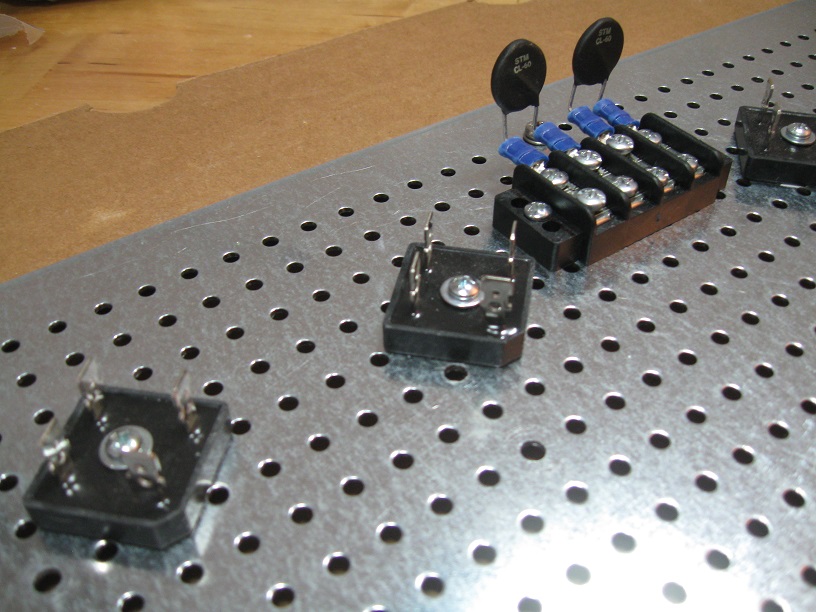
The two transformers are stacked in the center of the chassis. The top one is upside-down (yes, you can do that) just because of the limited length of the wires. What is not visible in the picture is that the bottom transformer has its own top plate, lock washer and nut installed. Using the oscilloscope attached to the output I started one channel and carefully rotated the transformer until no noise was induced into the output. I then locked it in place so rotating the top one would not disturb it.

I first tried to return the PSU ground to AC ground with wires and thermistors. Dropping the CL-60s straight to the chassis floor gave me the best results.
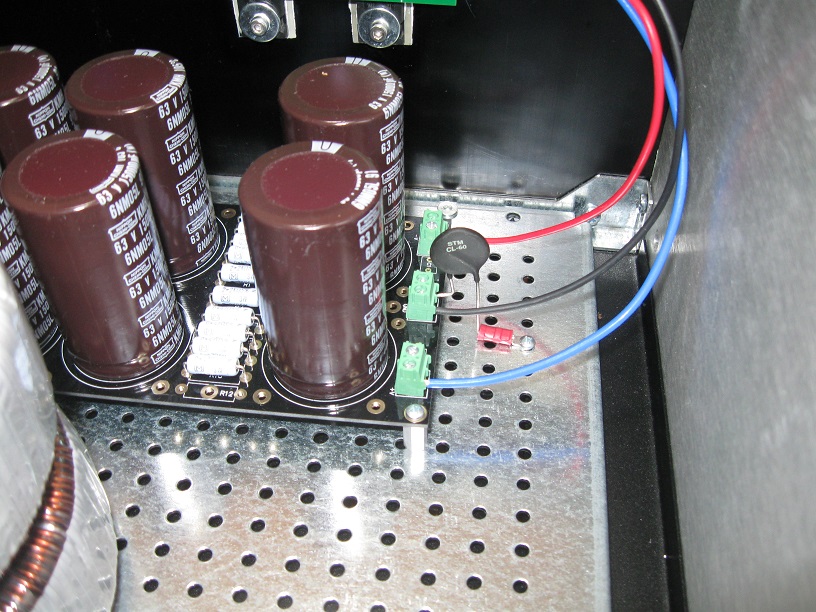
Below you can see the AC connections including the ground connection close to where it enters the chassis.
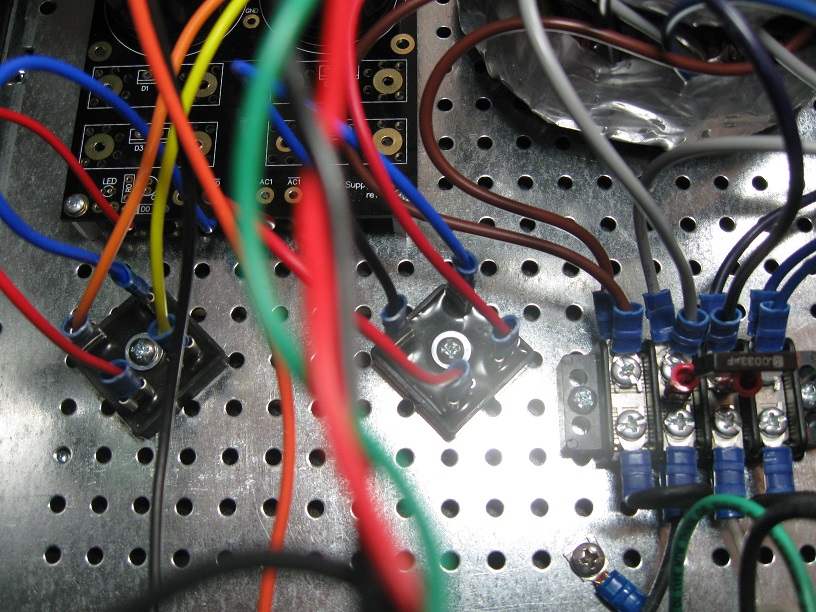
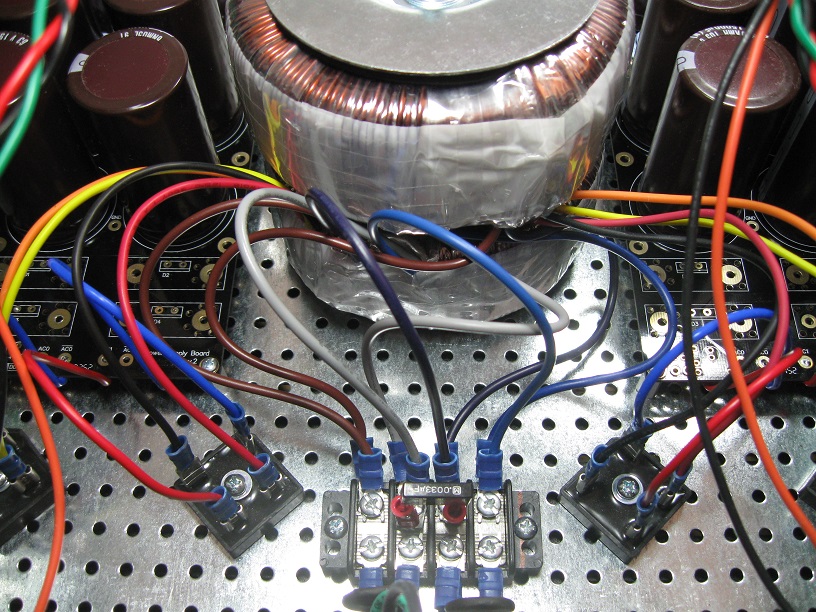
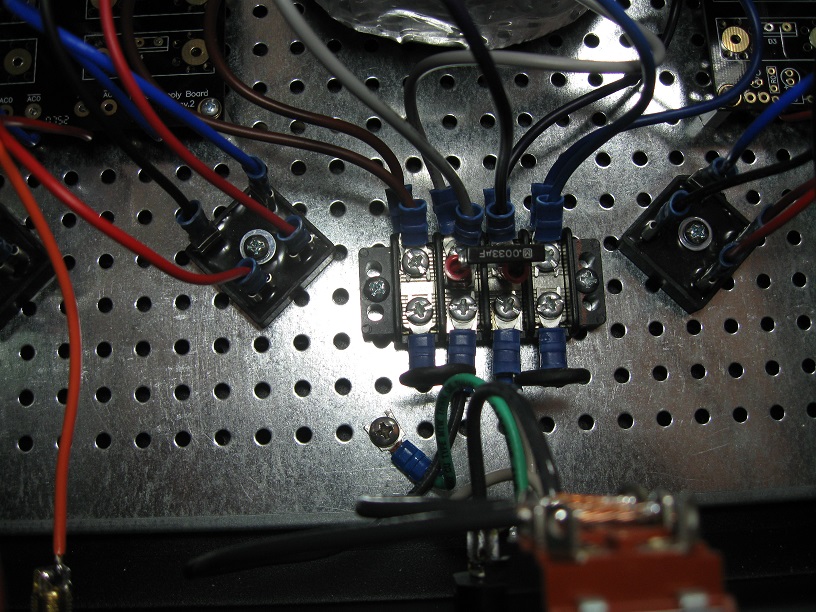
This is how the back panel looks from inside the case.
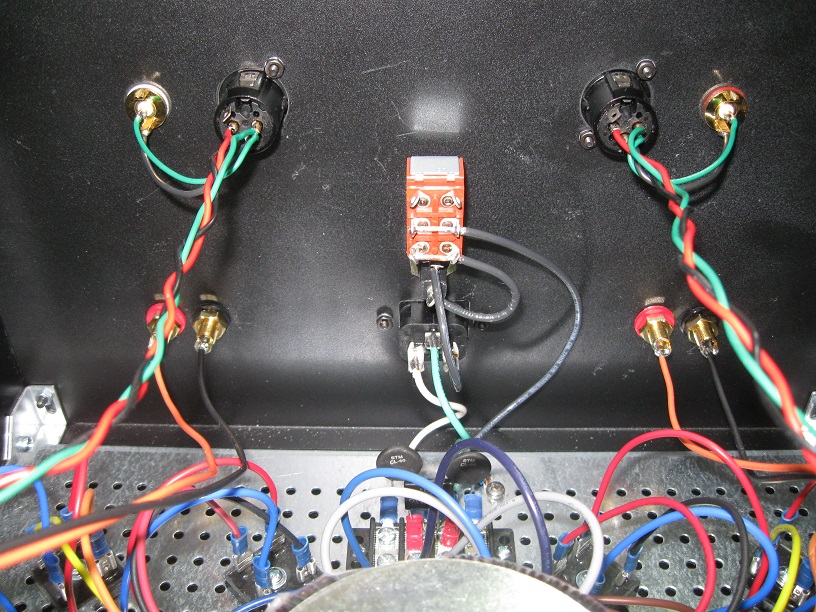
And this is the view from the outside.
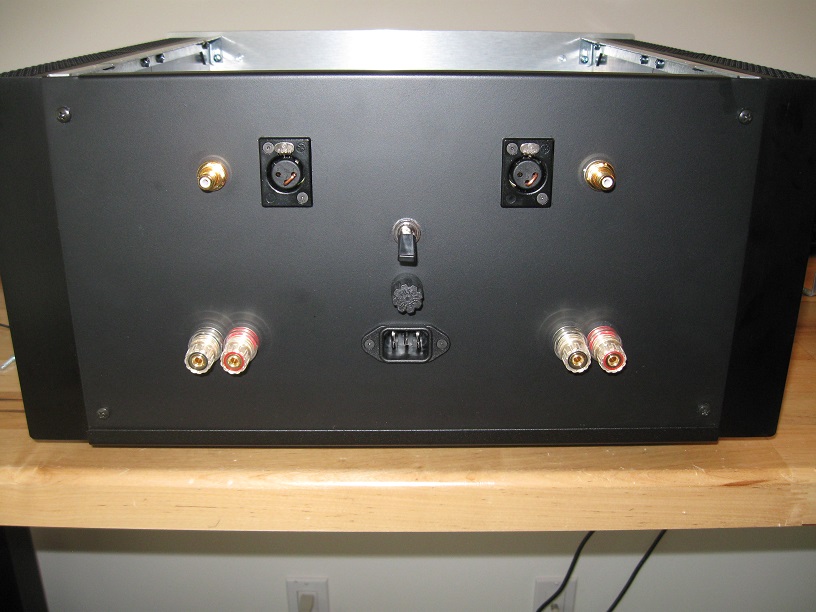
As I mentioned before my available time to work on audio projects is very limited, which sometimes causes delays in completing a build. Here are the final steps I took to resolve the remaining issues with the DIY Aleph J clone using the boards designed by Didiet.
After I determined that both the Ultrafast Recovery and Soft Recovery diodes caused mechanical hum in the transformers, I removed them from the boards and attached Fairchild bridges to the chassis perforated insert.
The two transformers are stacked in the center of the chassis. The top one is upside-down (yes, you can do that) just because of the limited length of the wires. What is not visible in the picture is that the bottom transformer has its own top plate, lock washer and nut installed. Using the oscilloscope attached to the output I started one channel and carefully rotated the transformer until no noise was induced into the output. I then locked it in place so rotating the top one would not disturb it.
I first tried to return the PSU ground to AC ground with wires and thermistors. Dropping the CL-60s straight to the chassis floor gave me the best results.
Below you can see the AC connections including the ground connection close to where it enters the chassis.
This is how the back panel looks from inside the case.
And this is the view from the outside.
Attachments
-
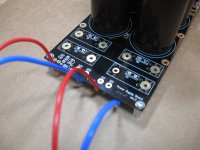 DiodesRemoved.JPG160.5 KB · Views: 1,372
DiodesRemoved.JPG160.5 KB · Views: 1,372 -
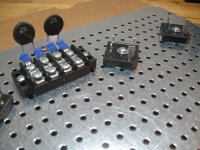 Bridges1.JPG175.1 KB · Views: 1,423
Bridges1.JPG175.1 KB · Views: 1,423 -
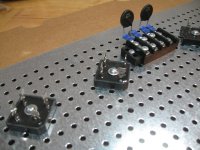 Bridges2.JPG169.9 KB · Views: 1,361
Bridges2.JPG169.9 KB · Views: 1,361 -
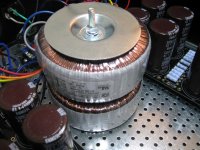 StackedTrafos.JPG207.6 KB · Views: 1,511
StackedTrafos.JPG207.6 KB · Views: 1,511 -
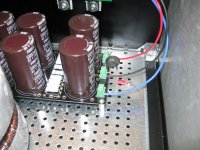 PSUGround.JPG220.3 KB · Views: 1,999
PSUGround.JPG220.3 KB · Views: 1,999 -
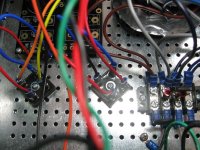 ACConnections1.JPG238.3 KB · Views: 1,334
ACConnections1.JPG238.3 KB · Views: 1,334 -
 ACConnections2.JPG272 KB · Views: 1,340
ACConnections2.JPG272 KB · Views: 1,340 -
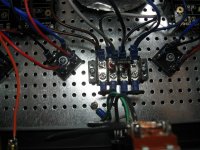 ACConnections3.JPG228.6 KB · Views: 1,924
ACConnections3.JPG228.6 KB · Views: 1,924 -
 BackPanelInterior.JPG258.8 KB · Views: 1,933
BackPanelInterior.JPG258.8 KB · Views: 1,933 -
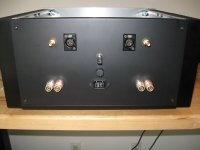 BackPanelExterior.JPG137.9 KB · Views: 1,342
BackPanelExterior.JPG137.9 KB · Views: 1,342
Final words...
The amplifier sounds fantastic! As for the noise issues, pausing the music and getting the ear close to the speaker I still could not hear any noise.
Things I have learned:
1) Didiet's boards are good
2) MUR and MSR diodes are not well suited for this application
3) Stacking transformers is a non-issue
4) Flipping one of them upside-down is not an issue either
5) Sometimes a wire connecting PSU ground to earth can be noisier than no wire at all
The amplifier sounds fantastic! As for the noise issues, pausing the music and getting the ear close to the speaker I still could not hear any noise.
Things I have learned:
1) Didiet's boards are good
2) MUR and MSR diodes are not well suited for this application
3) Stacking transformers is a non-issue
4) Flipping one of them upside-down is not an issue either
5) Sometimes a wire connecting PSU ground to earth can be noisier than no wire at all
Last edited:
what is the VA rating of the each of these transformers ? I have got the same power supply boards . planing to build A30.
grimberg - What a fantastic journey! You have done a couple of things that I would never have thought of, but very simple when shown - specifically where you put the thermistors and the rotating of the transformers.
Well done!
Well done!
Jim,
I am really glad to have purchased the perforated insert as it was very helpful in experimenting with the different setups. It went in and out of the case so many times we became good friends. It even stopped biting my fingertips after a while. Either that or I learned how to hold it properly.
🙂
I am really glad to have purchased the perforated insert as it was very helpful in experimenting with the different setups. It went in and out of the case so many times we became good friends. It even stopped biting my fingertips after a while. Either that or I learned how to hold it properly.
🙂
I pity I can't buy those cases because of shipping cost. That perforated plate is really nice for the floor. Saves a lot of drilling. I can now drill and tap M3, M4 and M5 holes with my eyes closed.
@grimberg.Thanks for the excellent write up and pics.It looks like I need to order a couple of standard rectifiers just in case my Schottky's cause problems.
I cannot see the rerctifiers being the issue unless they are underspec'd. The transformers are a little on the small side and could be the cause of the hum. I used mur860's in an f5t build and had no issue at all and they were being worked really hard. Grounding is a funny thing and you have to be careful in placing the blame. There is no reason that i no of that would cause a Schottky diode to induce hum when a standard didoe does not.
We'll see how it goes the schottky's work perfectly ok in the F5.I guess the standard block rectifiers will always come in handy as ground loop isolators.
I wonder though if it is not the fact that the BrianGT PSU boards forces you to use one bridge for both secondaries of the transformer, where he now uses one bridge per secondary via the block devices.
I seem to recall a previous posting by NP indicating that sharing a bridge between 2 secondaries may induce mechanical hum in the transformers if DC is passed back into the secondaries.
I seem to recall a previous posting by NP indicating that sharing a bridge between 2 secondaries may induce mechanical hum in the transformers if DC is passed back into the secondaries.
Very reasonable thought. You could easily bypass the onboard spot of the Brian GT boards and do the rectification off board.
I wonder though if it is not the fact that the BrianGT PSU boards forces you to use one bridge for both secondaries of the transformer, where he now uses one bridge per secondary via the block devices.
A very fair conclusion. I have used the BrianGT PSU once before, with TO-220 high-speed devices and the amp (an F5) is amongst the quietest I've built.
That is only an observation - not trying to discount your idea, merely share my experience with it.
I seem to recall a previous posting by NP indicating that sharing a bridge between 2 secondaries may induce mechanical hum in the transformers if DC is passed back into the secondaries.
That is my understanding of it as well.
The transformers are a little on the small side and could be the cause of the hum.
The original Aleph J uses one 300VA transformer. I am using two 250VA transformers for a clone build, how are they undersized?
Guys, just pay attention to the language I used, which was carefully chosen:
"MUR and MSR diodes are not well suited for this application"
Meaning exactly what is being discussed here: a single bridge of discrete devices being overtaxed in the way they were used.
I am not discarding MUR and MSR as good diodes. I also have not tested Schottky devices. What is clear is that once I replaced the four diodes with two external bridges, the mechanical hum disappeared.
"MUR and MSR diodes are not well suited for this application"
Meaning exactly what is being discussed here: a single bridge of discrete devices being overtaxed in the way they were used.
I am not discarding MUR and MSR as good diodes. I also have not tested Schottky devices. What is clear is that once I replaced the four diodes with two external bridges, the mechanical hum disappeared.
I am not discarding MUR and MSR as good diodes... ...What is clear is that once I replaced the four diodes with two external bridges, the mechanical hum disappeared.
I'm not surprised, I have been having similar issues with the F5T, and the pair of (slow) diode bridges is helping.
I'm sure there are plenty of builds with high-speed devices that are quiet. My (very limited) experience is showing me that the normal bridges might be a better place to begin for most builders, to keep issues to a minimum.
This leads to another question - is there any TO-220 or TO-247 discrete, slow diode of suitable rating that could be used in the BrianGT boards? Perhaps the single bridge isn't necessarily the issue -- the factory Aleph's were single bridge.
- Home
- Amplifiers
- Pass Labs
- Aleph J for Universal Mounting Spec